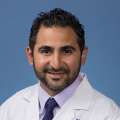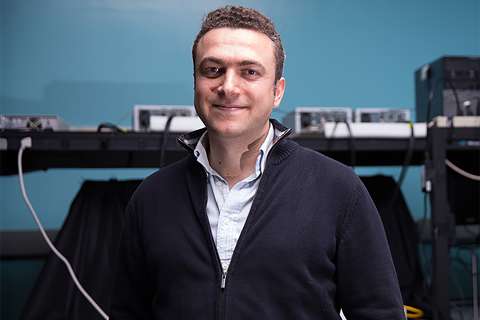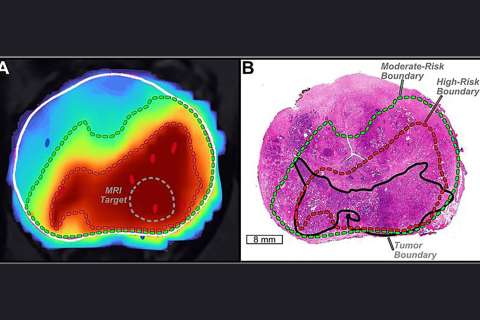For people of child-bearing age, the shock of receiving a cancer diagnosis is often closely followed by concerns about their fertility.
Helping patients understand their options – and helping them preserve their fertility before, during or even after cancer treatment – is the focus of the oncofertility team within the UCLA Health Adolescent and Young Adult Cancer Program. AYA is a part of the UCLA Health Jonsson Comprehensive Cancer Center providing specialized services for patients ages 15-39.
“For a patient, getting a diagnosis of infertility is second only to a diagnosis of cancer in terms of emotional impact,” said Juan Andino, MD, a urologist who specializes in infertility. “So, for this population, they’ve gotten two of the worst kinds of news if we don’t engage in this process of oncofertility to save fertility options for down the road.”
Oncofertility blends the fields of oncology, reproductive endocrinology and urology to help people undergoing cancer treatment preserve their future fertility and help cancer survivors evaluate ways they can expand their families.
Fertility concerns, options and urgency vary depending on the cancer diagnosis and treatment plan. Regardless, the conversation can feel overwhelming for patients, said Zain Al-Safi, MD, an obstetrics and gynecology fertility specialist at UCLA Health.
“They’ve just met with their oncologist, radiation oncologist, surgeon, and maybe a genetic counselor,” he said, “and now we’re talking about fertility preservation options that they may have to decide about quickly before they start their treatment.”
Urgent oncofertility referrals are seen within 72 hours, he said. “We offer them the options, and then they can decide whether to pursue these options first or proceed with their cancer treatment.”
The overall AYA oncofertility approach mirrors the just-released fertility preservation guidelines of the American Society of Clinical Oncology, Dr. Andino noted. “We’re thrilled that the work we’ve been doing at UCLA is in alignment with the gold standards and the most up-to-date data and evidence,” he said.
These guidelines also recommend that medically necessary fertility preservation, including oncofertility, be covered by insurance. As of May 2025, 20 states require this coverage and 19 states are considering similar legislation, although the specifics vary by state.
Preserving female fertility
Breast cancer is one of the most common cancers for females in the young-adult range, but it’s also one for which treatment can often be briefly postponed in order to pursue fertility preservation, Dr. Al-Safi said.
A key first step is assessing a patient’s baseline ovarian reserve, which can be measured via ultrasound by counting the number of antral follicles (small sacs within the ovaries that contain eggs), or by a blood test to assess the level of anti-mullerian hormone (AMH) being released by the ovaries. A higher AMH level indicates a greater number of eggs.
Even for patients who may not want fertility preservation right then, knowing their current ovarian reserve can be helpful information, Dr. Al-Safi said, as it can be assessed again after cancer treatment is completed.
The two standard options for preserving female fertility, egg freezing and embryo freezing, require about a two-week timeframe. Patients first undergo 10-12 days of daily hormone injections to stimulate their ovaries to encourage multiple follicles to grow. As this happens, the egg inside each follicle matures as well. Patients are then sedated for a brief egg-retrieval procedure. The eggs (or embryos, depending on the patient’s preferences) can be stored indefinitely.
“Based on the data that we have available, the length of storage doesn’t impact the quality of the eggs or the embryos,” Dr. Al-Safi said.
Not all patients can postpone cancer treatment, however. Patients diagnosed with leukemia or lymphoma may already be hospitalized and may need to start chemotherapy immediately after being diagnosed.
That said, “not all chemotherapies and radiation therapies are the same,” Dr. Al-Safi noted. Some are considered more gonadotoxic than others and decrease fertility either temporarily or permanently.
For a person with leukemia who has to have chemotherapy right away, for example, the initial treatment may not have a significant impact on the ovaries, allowing egg harvesting to take place before subsequent treatments such as a stem-cell transplant, which might require total-body radiation or conditioning chemotherapy. This secondary treatment would deplete the ovaries “basically of all eggs and the hormone-producing tissue” necessary for fertility and pregnancy, Dr. Al-Safi said.
Similarly, localized radiation outside of the pelvis area, such as for treatment of breast cancer, may not pose much of a fertility risk, he noted, whereas direct pelvic radiation for cervical cancer would have more of an impact.
The patient’s age is also an important factor when gauging how future fertility may be affected.
“Patients who are older, with lower ovarian reserves, may face more damage or may go into premature menopause because of the treatments,” he said. “Sometimes, the cancer itself can impact the reproductive system, but a lot of times what we discuss is the effect of treatment on their future reproduction.”
Adolescent patients may not yet be thinking about getting pregnant, he noted; in these scenarios, their parents may also be part of the conversation. “As long as they’ve already started menstruating, we can offer these fertility preservation options,” he said.
Male sperm preservation
Although preserving fertility for males is a quicker process, there are still a number of considerations and options based on treatment timing and other factors.
Among adolescent and young-adult males, the most common cancer is testicular cancer, Dr. Andino said. “If there’s a testicular mass or lesion, the first step in their treatment journey may be losing a testicle. Most of the time, the remaining testicle can still produce testosterone and sperm, he noted. However, fertility preservation becomes “incredibly important” if the patient needs additional chemotherapy or radiation therapy.
Other common cancers in this age group that can affect fertility include lymphoma, leukemia and other types of blood cancers, he said, as well as cancer treatments involving chemotherapy or radiation or those requiring surgery in the pelvic area, such as colorectal cancers.
In all of these cases, cryopreserved sperm (which, like eggs, can be stored indefinitely, based on current research) allows patients to preserve their future fertility.
The quickest and least invasive way is to obtain ejaculated sperm. “It doesn’t require a procedure,” Dr. Andino noted. “It doesn’t require anesthesia. And there’s no complication rate.”
This isn’t always an option, however. Younger patients may not yet know if they’re able to ejaculate or, due to cultural and religious beliefs, may not have the option to provide ejaculated samples, Dr. Andino said. In some older patients, meanwhile, the level of pain or the pain medications they’re taking may make ejaculation difficult, he said, or there may be cases where the semen may not have sperm – a diagnosis called azoospermia.
“In many, many cases, we can do a testicular sperm extraction (TESE), and that can allow us to find sperm inside the testicle that can be frozen for future use,” Dr. Andino said. There’s also a more specialized version, called a microTESE, which involves using a surgical microscope to identify testicular tissue that may contain sperm.
“Even when there’s no sperm in the ejaculate, around 40 percent of the time we may be able to identify pockets of sperm in the testicle that can be used for assisted reproduction,” he said.
Timing of treatment is also a factor: Even for a patient who’s already hospitalized the ideal scenario is being able to cryopreserve sperm before chemotherapy or radiation begins.
“If this is of high importance to the patient, we may be able to push back chemotherapy by one to two days,” Dr. Andino said. “But there are cases where someone’s already started therapy and we can still have these conversations and offer the option of sperm preservation early in the treatment cycles.”
These more urgent situations are more likely with the types of cancers and procedures adolescents may face, he noted, whereas young adults may be diagnosed in an outpatient setting and have more time to review their options before making a decision.
The oncofertility group at UCLA also sees patients who have completed cancer treatment elsewhere but didn’t preserve their sperm in advance due to timing or other factors. “Even if their sperm production has been affected and they don’t have sperm based on a semen analysis, or have very low amounts, we can still fall back on these two categories of sperm extraction,” Dr. Andino said.
He also recommends that patients return a couple of years post-treatment for a repeat semen analysis. “We don’t have predictive tools to know who’s going to have a permanent effect causing infertility versus who’s going to have a temporary effect,” he noted. “Maybe their body bounces back and is now producing sperm. The cryopreservation really serves almost like an insurance policy.”
Raising awareness
The goal of the AYA oncofertility program is to ensure that patients being treated at any of UCLA’s cancer centers can be referred to an oncofertility specialist to discuss their options.
“The biggest coordination has been with the hematology and oncology physicians and providers – the folks who are seeing the patient for the first time and providing the cancer diagnosis,” Dr. Andino said.
The program also helps provide patients with the documentation and guidance to work with their insurance plans to determine the extent of coverage, he said, given that fertility preservation services for non-MediCal patients may be eligible for coverage under California law.
“Particularly in younger patients, cancer therapies have gotten better, so they’re surviving cancer and living longer, fuller lives,” Dr. Andino said. “We want to empower them to ask about treatments if fertility is something on their mind for the future. It’s a really important part of whole-person care.”





